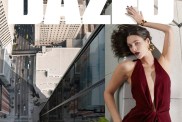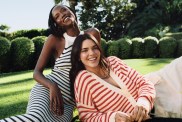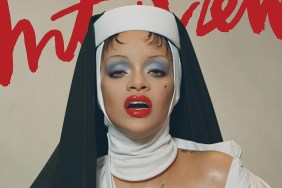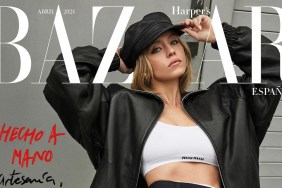Matthew Miele: I’m a screenwriter by trade. I had done a couple of independent feature films that got some attention for the writing, I think, more than the directing that I did. I started getting hired on bigger screenplays, doing some doctoring and stuff. I had one project in mind — I’m a big fan of Breakfast at Tiffany‘s, so I had this one project in mind about a character in New York who saw Audrey Hepburn get out of that cab in the beginning of the movie and walk to the window. I’m really enamored by that time in New York and also that moment in cinema, and I was just curious — who would be up at that hour? Who would be watching that moment? And I arrived at the window dresser at Bergdorf’s. That was sort of my jumping off point for this character I created. And I needed permission to shoot in the store for at least a third of the film. Through a couple of degrees of people I knew a Goodman relative and he was the one to introduce me to some of the company brass.
When I met with them, I sat down and said, “I really want to have my research down pat, I want to make sure I know this story in and out, do you have an archive I can access so that I can research my screenplay and make sure I have all my characters right?” And they said, “No, we have no archive.” And that really was the thing that set off this notion of chronicling the store. I was just shocked that a century-old store had no real archive beyond some black-and-white photos on a wall on the 7th floor. I just explained to them, “Look, you’re missing a great opportunity, because there are fashion films that are very hot right now. You could probably get everyone under the sun to speak to us about their experience here. And beyond that, you guys are an incubator for talent, more than just a retail extravaganza, it’s a place where designers are born, really. It’s like the Good Housekeeping Seal of Approval.”
So, as that happened, I think the senior VP was … her brain started working and we continued a discussion and it turned into a documentary. So the feature was kind of pushed aside and I went full force into this documentary because I knew it was something that had great appeal, both for people that loved Berdorf’s and for people that were very curious about it.
tFS: So what did your research process end up looking like, without an archive? The oral history element…
MM: With the designers and some of the histories of their existence there, it came straight from them. They told me about who they worked with, like Dawn Mello and Linda Fargo. And even going back a little farther with the original creative director who worked with Jackie O. and some of the other people. Bergdorf’s had a few key things that they liked to celebrate. That Jackie O. dress that the Berdorf’s Creative Director designed for the inauguration. Other things like that are Liz Taylor, you know being one of their favorite clients, John Lennon in that famous story of the fur coats. There were some legends that I had to verify and corroborate, but those were good jumping off points too.
tFS: How did you feel about Bergdorf’s before you started working on the documentary? How well did you know the store? Had you ever shopped there before?
MM: I’m a fashion outsider, I’m certainly not a clotheshorse. I don’t think I had purchased anything at Bergdorf’s prior to getting interested in the window dresser aspect. I’m a HUGE fan of the windows. I was taken every year, I’m sure like many children, to the windows — to each store, Saks, Lord & Taylor, Bergdorf’s. It was a tradition in my family and it was something that was ingrained. And I always thought, “Wow, they’re so cinematic. They’re so rich. I want to know how those are creative, and who’s doing it.” And for a long time I thought, “Wow, what a great job that would be.” And I’m still fond of that aspect of design. But — no, I was a fashion outsider, I had never shopped there, was just an admirer of the windows. And I think that helped me when it came to the interviews. I’m not a fashion student, I don’t aspire to be a designer. I don’t have a lot of design sense — maybe that’s insulting me, but whatever.

The interviews, like with Giorgio Armani and Oscar de la Renta and Diane Von Furstenberg, I think they favored my being an outsider because had I been a fashion student and known the breadth and the weight of who these people were, and if I idolized them or if I were intimidated in any way, I think the interview would have gone much differently, and I wouldn’t have been able to get them to open up, and also to be a little more fun and off-the-cuff with some of the remarks. Because I think I would have been scared to say certain things or ask certain things. I guess maybe they would assume I knew things.
Especially with Karl [Lagerfeld], I had such a great time with him, because he was so funny. When I walked in the room, the publicist said, “He’s not going to answer any of your questions.” And I said, “Well, why am I here?” And he sat down and he said, “Okay, what do you want to ask me?” And I was immediately like…I threw out that notion of the intimidation factor and I thought, let’s just go for it. And I hit him with everything, he became very funny and comical to me. We put some of that in the film, but also we have a great outtake that will be released with some of his more classic lines.
tFS: One of the challenging things about working in fashion media is how relationships with brands determine the kind of access you can get to tell a story and essentially do your job. How did you balance your interests as a filmmaker with the pressures of working with such a well-known luxury brand?
MM: There were a few things I knew going in. Documentaries are usually done on people or events in history or places. They’re rarely done on stores — even in the fashion documentary realm. The documentary that was done on The September Issue was really about Anna and The Last Emperor was really about Valentino and Zipped about Isaac [Mizrahi]. So I knew I had a unique subject, but I also knew I was up against the notion of … I’m doing a business, a brand. And I don’t want this to come across as any kind of informercial for the store. It was more about trying to figure out, how do I bring integrity to the piece? How am I going to allow the steel curtain of Bergdorf’s to open up their doors and get them really raw, and allow me to watch [principal tastemaker] Linda [Fargo] reject a designer or [top personal shopper] Betty [Halbreich] really be off-the-cuff with a client and really give me…not off-color remarks but to just be real.
I felt like there were only a few things I could do: 1) It was independently financed, which I insisted on. I didn’t want Bergdorf’s to put in any money on this, because then it does feel a little skewed. So it was financed by independent investors who were brought together to do this. 2) I felt like the length of time…I shot it for a year, so I knew by the time the third month rolled around, they would be more comfortable with me and they would start allowing me to be a fly-on-the-wall rather than being so aware of the cameras. So that helped. 3) With the publicists and with the designers, the interviews… Bergdorf’s was the lead in terms of authorizing the documentaries, so everyone was willing to talk and everyone was willing to come to the table and say what they loved about the store because beyond being clients, most of them were also in the store as designers. Some of the tougher interviews were people who weren’t in or didn’t get in, and they didn’t want to speak or didn’t want to…you know, expose that fact. But we convinced them — you know, like Lauren Bush and Veronica Beard. We allowed them to state that despite the fact that they didn’t get in, they got into other stores. So there was a bit of a challenge all the way through with some of the designers wanting to know, “What kind of piece is this? Where is it going to end up?” And I told them, throughout: “This is going to be in theaters, this is going to be a real spectacle. We’re going to make sure this film goes all the way.” Because I felt, from the very beginning…once Karl committed to an interview, once the Olsen twins committed to an interview, once Marc Jacobs did. I knew then that with an A-list grouping, it was going to be great.
However, we did 175 interviews. That to me is such an extraordinary number, compared to other documentaries. We tried to get everyone in there, but you’re forced to only use a couple lines. Which is a shame but it also nurtures a very fast-paced, fun, sometimes-comedic/sometimes-not film. I think it favored us in the end and it’s like, a carnival of faces and names.

tFS: What was your favorite interview?
MM: [Loooong pause] There was one, Harold Koda at The Metropolitan Museum was a good one because he had such a vast knowledge of windows and the history of windows, and I never knew the extent to which the art form went back. It started with L. Frank Baum, author of The Wizard of Oz, who was a ‘window trimmer,’ as they used to put it. He started the National Association of Window Trimmers. There are such creative people who were involved with window design. Andy Warhol and Halston. Just great, great people. And artists. And that history was something so fascinating to me, because it really opened my eyes to the people behind the windows and their legacy really what they’re inheriting. And [Koda] was one of my favorites, because he knew and had a knowledge of it, and I don’t think many people do. So that was really great.
And I’ll say…Karl was too, because it was such a surprise. Here’s this gentleman walking in, in his classic Karl look. He sits on the couch, he rearranges all the pillows and we knew that and we knew that we were talking to one of the godfathers of fashion but he started cracking jokes and just being so relaxed and candid that — I think he knew we were having a good time with that one. And you know, by the end he was like, “Let’s keep going.” I think he enjoyed himself.
tFS: Are you going to watch the Lena Dunham show about Betty?
MM: I actually asked Betty recently if that was real or not and … because they ran with that in all of these different columns and she told me that she hadn’t even met with Lena yet. However, I know that since we spoke, she has met with her. I’ll watch it certainly, I just don’t know what they have in mind. I don’t know if it’s a docu-series or if it’s going to be an actress playing Betty in all of her little adventures but Betty is a character and she is a relic of the Forties but she’s so relevant and such a spitfire, even today. She’s … I think in her eighties and so full of vinegar and like, one of the relatives you wish you had in certain moments in your life.
Will I watch it? Yeah, absolutely. Am I a little jealous that she’s doing it? Yeah, kind of. Betty’s such a great character, I wish she went further with it. I actually have the idea to do that, but I know that HBO is pretty powerful, so we’ll see what happens.
tFS: Betty was one of my favorite parts of the film. She gave such a great interview and was so … surprising, I thought.
MM: I was like, “Who can I speak to to give me a little fleshing out on you and who you are?” And she rattled off all those names you see talking about her, and that’s how we got those interviews — they all came forward for her.

Scatter My Ashes at Berdorf’s opens in theaters on May 3.
Images via eOne, Getty







